Movement Time and Subjective Rating of Difficulty in Real and Virtual Pipe Transferring Tasks
Abstract
:1. Introduction
2. Materials and Methods
2.1. Human Participants
2.2. Pipes and AR Device
2.3. Pipe Transferring Tasks
2.4. Data Collection and Analysis
3. Results
3.1. Movement Time
3.2. Subjective Rating of Difficulty
3.3. Regression Analyses of Movement Time
4. Discussion
4.1. Virtual and Real Pipe Transfers
4.2. MT Modeling
4.3. Limitations of the Study
5. Conclusions
Author Contributions
Funding
Institutional Review Board Statement
Informed Consent Statement
Data Availability Statement
Acknowledgments
Conflicts of Interest
References
- Langolf, G.D.; Chaffin, D.B.; Foulke, J.A. An investigation of Fitts’ law using a wide range of movement amplitudes. J. Mot. Behav. 1976, 8, 113–128. [Google Scholar] [CrossRef] [PubMed]
- Fitts, P.M. The information capacity of the human motor system in controlling the amplitude of movement. J. Exp. Psychol. 1954, 47, 381–391. [Google Scholar] [CrossRef]
- Fitts, P.M.; Peterson, J.R. Information capacity of discrete motor responses. J. Exp. Psychol. 1964, 67, 103–112. [Google Scholar] [CrossRef]
- Xu, X.; Qin, J.; Zhang, T.; Lin, J.-H. The effect of age on the hand movement time during machine paced assembly tasks for female workers. Int. J. Ind. Ergon. 2014, 44, 148–152. [Google Scholar] [CrossRef]
- Zhao, C.; Li, K.W.; Peng, L. Modeling of motion time for pointing tasks in real and augmented reality environments. Appl. Sci. 2023, 13, 788. [Google Scholar] [CrossRef]
- Baird, K.M.; Hoffmann, E.R.; Drury, C.G. The effects of probe length on Fitts’ law. Appl. Ergon. 2022, 33, 9–14. [Google Scholar] [CrossRef] [PubMed]
- Murakami, H.; Yamada, N. Fitts’ law when errors are not allowed: Quantification of reciprocating trajectories and estimating information processing. Acta Psychol. 2021, 220, 103418. [Google Scholar] [CrossRef]
- Takeda, M.; Sato, T.; Saito, H.; Iwasaki, H.; Nambu, I.; Wada, Y. Explanation of Fitts’ law in reaching movement based on human arm dynamics. Sci. Rep. 2019, 9, 19804. [Google Scholar] [CrossRef] [PubMed]
- Wu, J.; Yang, J.; Honda, T. Fitts’ law holds for pointing movements under conditions of restricted visual feedback. Hum. Mov. Sci. 2010, 29, 882–892. [Google Scholar] [CrossRef] [PubMed]
- Drury, C.G. Application of Fitts’ law to foot pedal design. Hum. Factors 1975, 17, 368–373. [Google Scholar] [CrossRef]
- Chan, A.H.S.; Hoffmann, E.R. Effect of movement direction and sitting/standing on leg movement time. Int. J. Ind. Ergon. 2015, 47, 30–36. [Google Scholar] [CrossRef]
- Chan, A.H.S.; Hoffmann, E.R.; Wong, K.P. Seated leg/foot ballistic and visually-controlled movements. Int. J. Ind. Ergon. 2016, 56, 25–31. [Google Scholar] [CrossRef]
- Chan, A.H.S.; Hoffmann, E.R.; Ip, K.M.; Siu, S.C.H. Leg/foot movement times with lateral constraints. Int. J. Ind. Ergon. 2018, 67, 6–312. [Google Scholar] [CrossRef]
- Passmore, S.R.; Johnson, M.G.; Kriellaars, D.J.; Pelleck, V.; Enright, A.; Glazebrook, C.M. Fitts’s Law using lower extremity movement: Performance driven outcomes for degenerative lumbar spinal stenosis. Hum. Mov. Sci. 2015, 44, 277–286. [Google Scholar] [CrossRef]
- Andres, R.O.; Hartung, K.J. Prediction of Head Movement Time Using Fitts’ Law. Hum. Factors 1989, 31, 703–713. [Google Scholar] [CrossRef]
- Radwin, R.G.; Vanderheiden, G.C.; Lin, M.-L. A method for evaluating head-controlled computer input device using Fitts’ law. Hum. Factors 1990, 32, 423–438. [Google Scholar] [CrossRef]
- Hoffmann, E.R.; Chan, A.H.S.; Heung, P.T. Head rotation movement times. Hum. Factors 2017, 59, 986–994. [Google Scholar] [CrossRef]
- Jagacinski, R.J.; Monk, D.L. Fitts’ law in two dimensions with hand and head movements. J. Mot. Behav. 1985, 8, 113–128. [Google Scholar] [CrossRef]
- So, R.H.Y.; Chung, G.K.M.; Goonetilleke, R.S. Target-directed head movements in a dead-coupled virtual environment: Predicting the effects of lags using Fitts’ Law. Hum. Factors 1999, 41, 474–486. [Google Scholar] [CrossRef]
- Hoffmann, E.R.; Chan, A.H.S. Movement of loads with trunk rotation. Ergonomics 2015, 58, 1547–1556. [Google Scholar] [CrossRef]
- Groen, B.E.; Altmann, V.C.; Verhagen, R.W.; Vanlandewijck, Y.C.; Keijsers, N.L.W. Fitts’ law is applicable to trunk coordination measurements in a sitting position. J. Mot. Behav. 2019, 51, 43–48. [Google Scholar] [CrossRef]
- Shannon, C.E. A mathematical theory of communication. Bell Syst. Tech. J. 1948, 27, 379–423. [Google Scholar] [CrossRef]
- Tosini, L.; Gomes, A.C.; Corbetta, D.M.; Magalhães, F.H.; Meira, C.M., Jr. Extroversion-related differences in gaze behavior during a computer task for assessing speed–accuracy trade-off: Implications for sensor-based applications. Sensors 2023, 23, 6483. [Google Scholar] [CrossRef]
- Sleimen-Malkoun, R.; Temprado, J.-J.; Huys, R.; Jirsa, V.; Berton, E. Is Fitts’ law continuous in discrete aiming? PLoS ONE 2012, 7, e41190. [Google Scholar] [CrossRef] [PubMed]
- Guiard, Y.; Olafsdottir, H.B. On the measurement of movement difficulty in the standard approach to Fitts’ law. PLoS ONE 2011, 6, e24389. [Google Scholar] [CrossRef]
- Crossman, E.R.F.W. The Measurement of Perceptual Load in Manual Operations. Unpublished. Ph.D. Thesis, University of Birmingham, Birmingham, UK, 1956. [Google Scholar]
- Welford, A.T. The measurement of sensory-motor performance: Survey and reappraisal of twelve years progress. Ergonomics 1960, 3, 189–230. [Google Scholar] [CrossRef]
- Mackenzie, I.S. A note on the information-theoretic basis for Fitts’ law. J. Mot. Behav. 1989, 21, 323–330. [Google Scholar] [CrossRef]
- Kvålseth, T.O. An alternative to Fitts’ law. Bull. Psychon. Soc. 1980, 16, 371–373. [Google Scholar] [CrossRef]
- Meyer, D.E.; Abrams, R.A.; Kornblum, S.; Wright, C.E.; Smith, K.J. Optimality in human motor performance: Ideal control of rapid aimed movements. Psychol. Rev. 1988, 95, 340. [Google Scholar] [CrossRef]
- Chan, A.H.S.; Ng, A.W.Y. Lateral foot-movement times in sitting and standing postures. Percept. Mot. Ski. 2008, 106, 215–224. [Google Scholar] [CrossRef]
- Gan, K.-C.; Hoffmann, E.R. Geometrical conditions for ballistic and visually controlled movements. Ergonomics 1988, 31, 829–839. [Google Scholar] [CrossRef] [PubMed]
- Hoffmann, E.R. Effective target tolerance in an inverted Fitts’ task. Ergonomics 1995, 38, 828–836. [Google Scholar] [CrossRef]
- McGuffin, M.J.; Balakrishnan, R. Fitts’ Law and expanding targets: Experimental studies and designs for user interfaces. ACM Trans. Comput.-Hum. Interact. 2005, 12, 388–422. [Google Scholar] [CrossRef]
- Lin, C.J.; Cheng, C.-F. Modeling the effect of target shape on movement performance in a 1D2D Fitts Task. Mathematics 2022, 10, 2568. [Google Scholar] [CrossRef]
- Lin, C.J.; Cheng, C.-F. A new approach to modeling the prediction of movement time. Mathematics 2021, 9, 1585. [Google Scholar] [CrossRef]
- Murata, A.; Iwase, H. Extending Fitts’ law to a three-dimensional pointing task. Hum. Mov. Sci. 2001, 20, 791–805. [Google Scholar] [CrossRef]
- Cha, Y.; Myung, R. Extended Fitts’ law for 3D pointing tasks using 3D target arrangements. Int. J. Ind. Ergon. 2013, 43, 350–355. [Google Scholar] [CrossRef]
- Machuca, M.D.B.; Stuerzlinger, W. The effect of stereo display deficiencies on virtual hand pointing. In Proceedings of the CHI Conference on Human Factors in Computing Systems Proceedings (CHI2019), Glasgow, UK, 4–9 May 2019; p. 14. [Google Scholar] [CrossRef]
- Clark, L.D.; Bhagat, A.B.; Riggs, S.L. Extending Fitts’ law in three-dimensional virtual environments with current low-cost virtual reality technology. Int. J. Hum. Comput. Stud. 2020, 139, 102413. [Google Scholar] [CrossRef]
- Deng, C.-L.; Geng, P.; Hu, Y.-F.; Kuai, S.-G. Beyond Fitts’ law: A three-phase model predicts movement time to position an object in an immersive 3D virtual environment. Hum. Factors 2019, 61, 879–894. [Google Scholar] [CrossRef]
- Bright, A.G.; Ponis, S.T. Introducing gamification in the AR-enhanced order picking process: A proposed approach. Logistics 2021, 5, 14. [Google Scholar] [CrossRef]
- Caria, M.; Todde, G.; Sara, G.; Piras, M.; Pazzona, A. Performance and usability of smart glasses for augmented reality in precision livestock farming operations. Appl. Sci. 2020, 10, 2318. [Google Scholar] [CrossRef]
- Dorloh, H.; Li, K.W.; Khaday, S. Presenting Job Instructions Using an Augmented Reality Device, a Printed Manual, and a Video Display for Assembly and Disassembly Tasks: What Are the Differences? Appl. Sci. 2023, 13, 2186. [Google Scholar] [CrossRef]
- Kim, S.; Nussbaum, M.A.; Gabbard, J.L. Influences of augmented reality head-worn display type and user interface design on performance and usability in simulated warehouse order picking. Appl. Ergon. 2019, 74, 186–193. [Google Scholar] [CrossRef]
- Cabero-Almenara, J.; Barroso-Osuna, J.; Llorente-Cejudo, C.; Martínez, M. Educational uses of augmented reality (AR): Experiences in educational science. Sustainability 2019, 11, 4990. [Google Scholar] [CrossRef]
- Bortolini, M.; Faccio, M.; Galizia, F.G.; Gamberi, M.; Pilati, F. Adaptive Automation Assembly Systems in the Industry 4.0 Era: A Reference Framework and Full–Scale Prototype. Appl. Sci. 2021, 11, 1256. [Google Scholar] [CrossRef]
- Hancock, W.M.; Langolf, G.D.; Clark, D.O. Development of standard data for stereoscopic microscope work. AIIE Trans. 1973, 5, 113–118. [Google Scholar] [CrossRef]
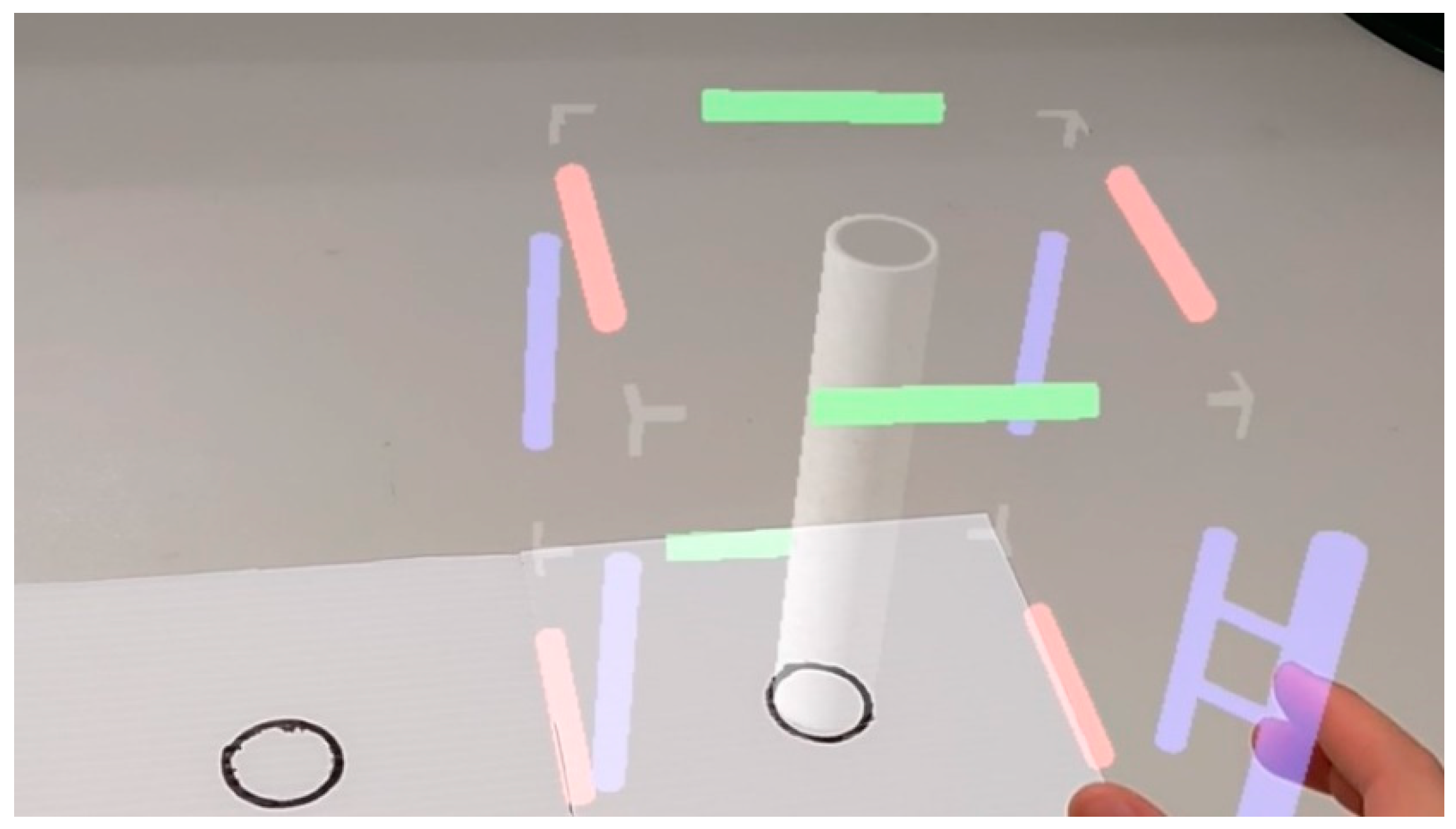
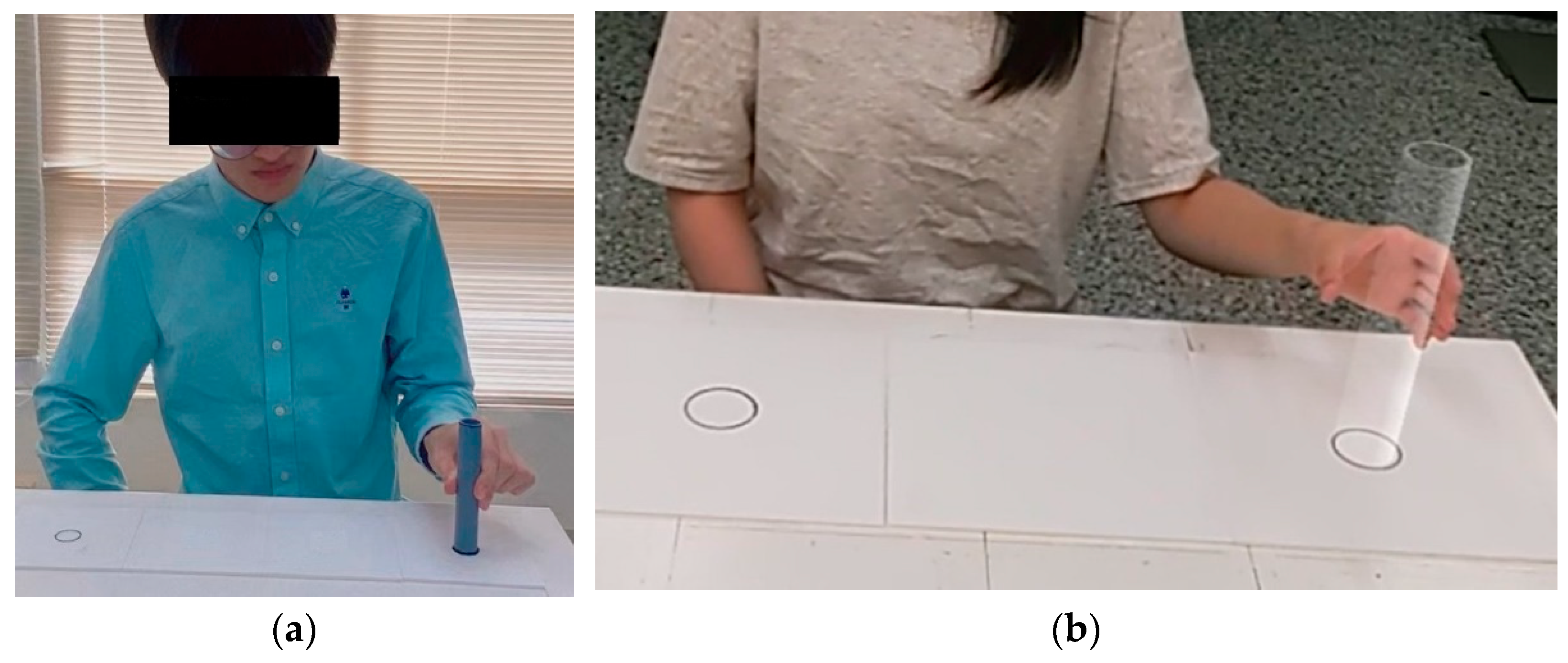
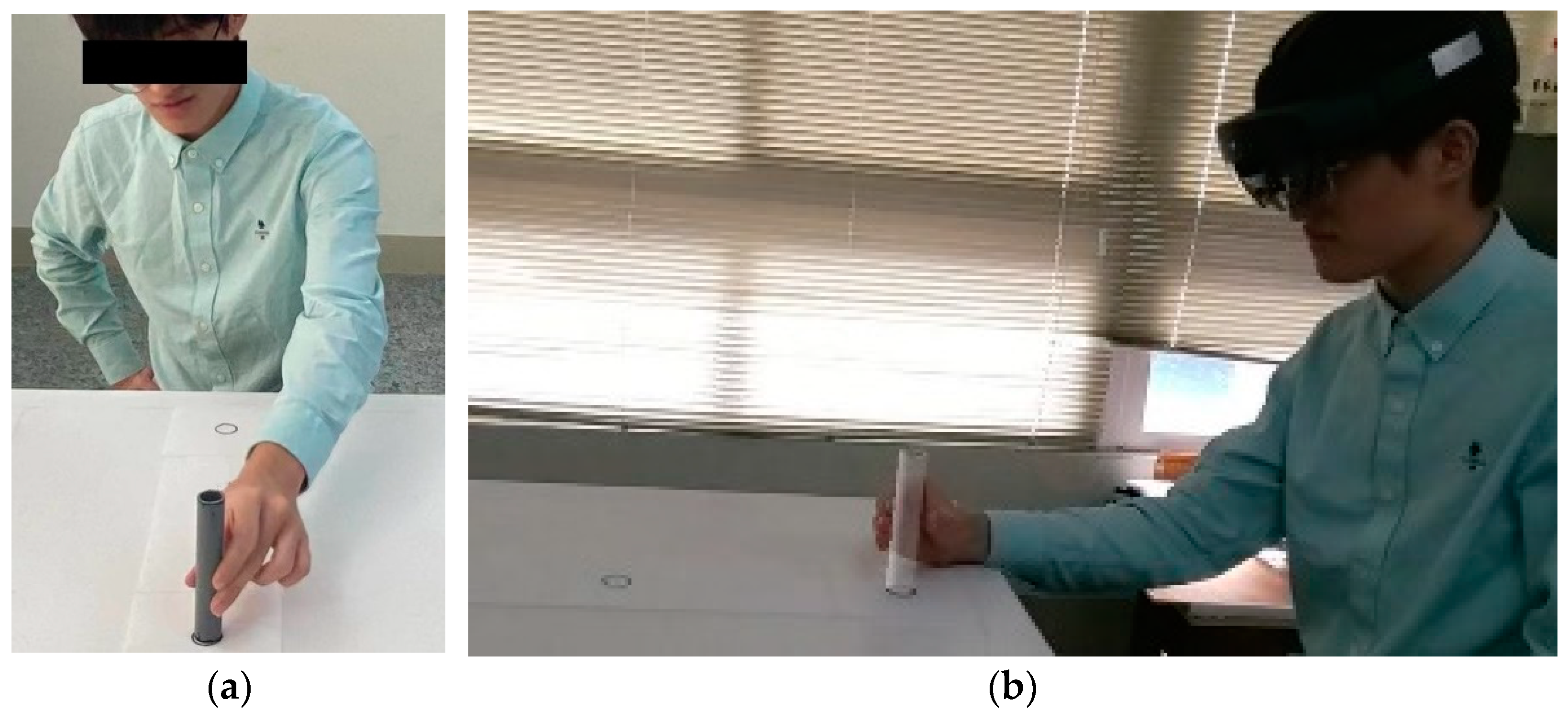
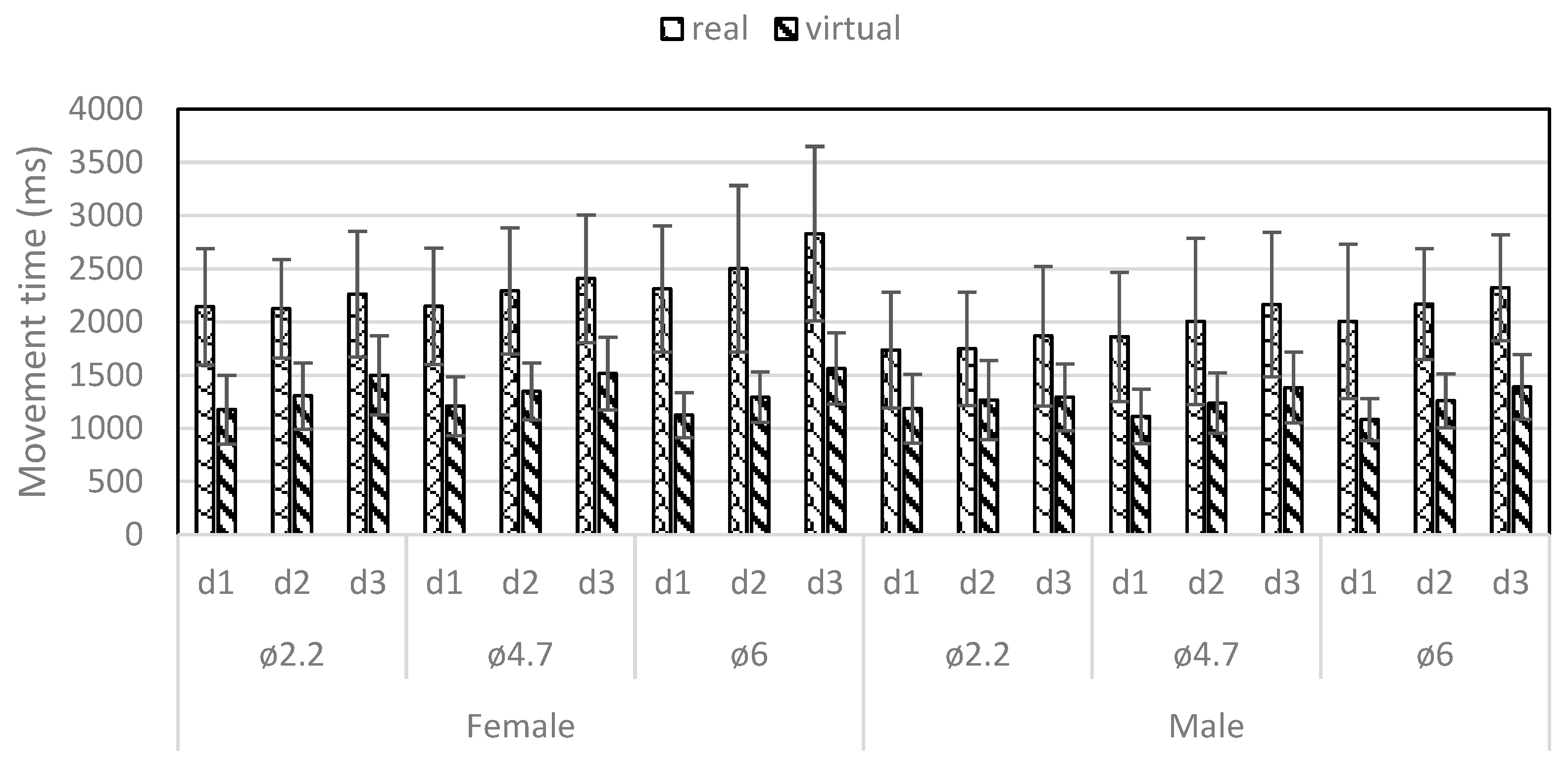
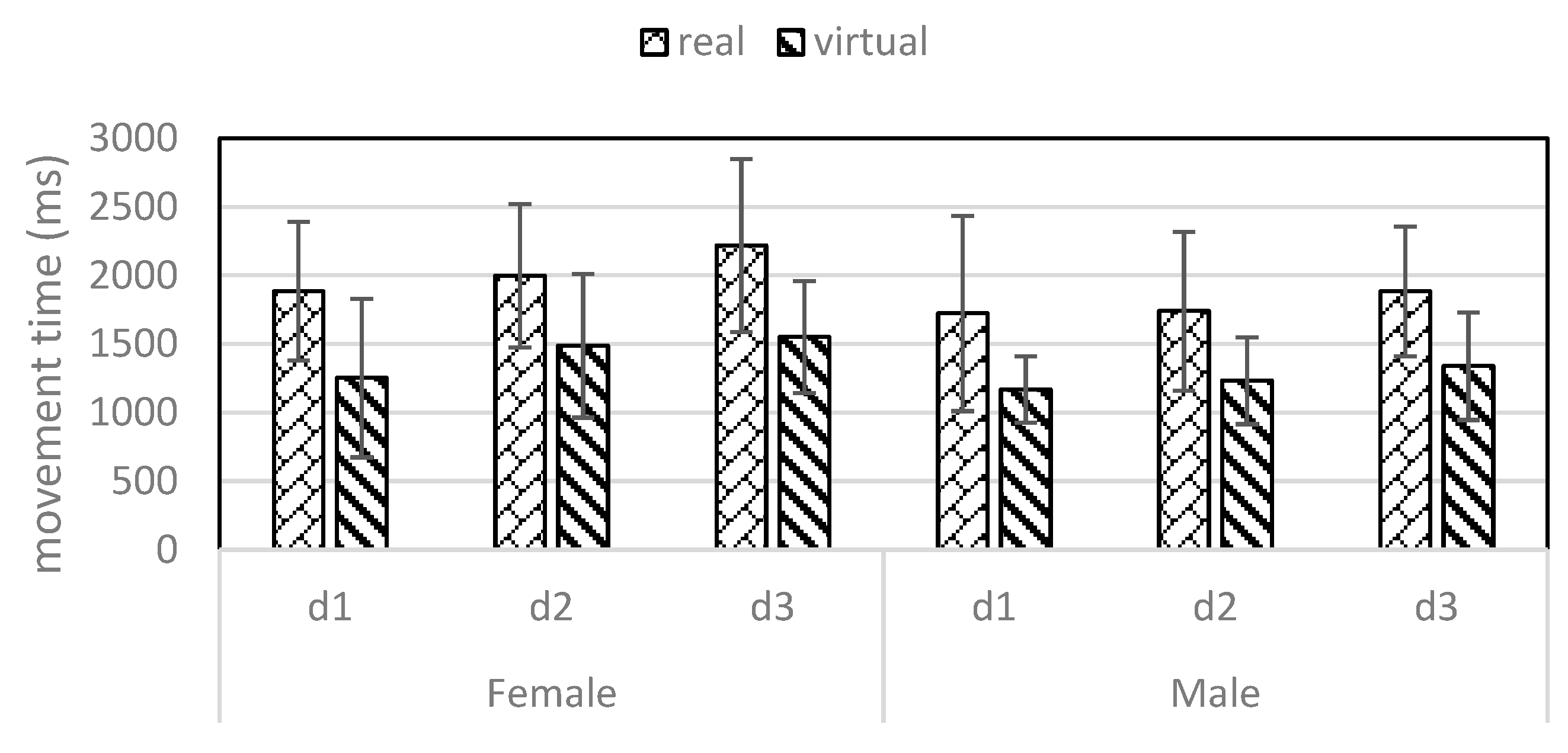
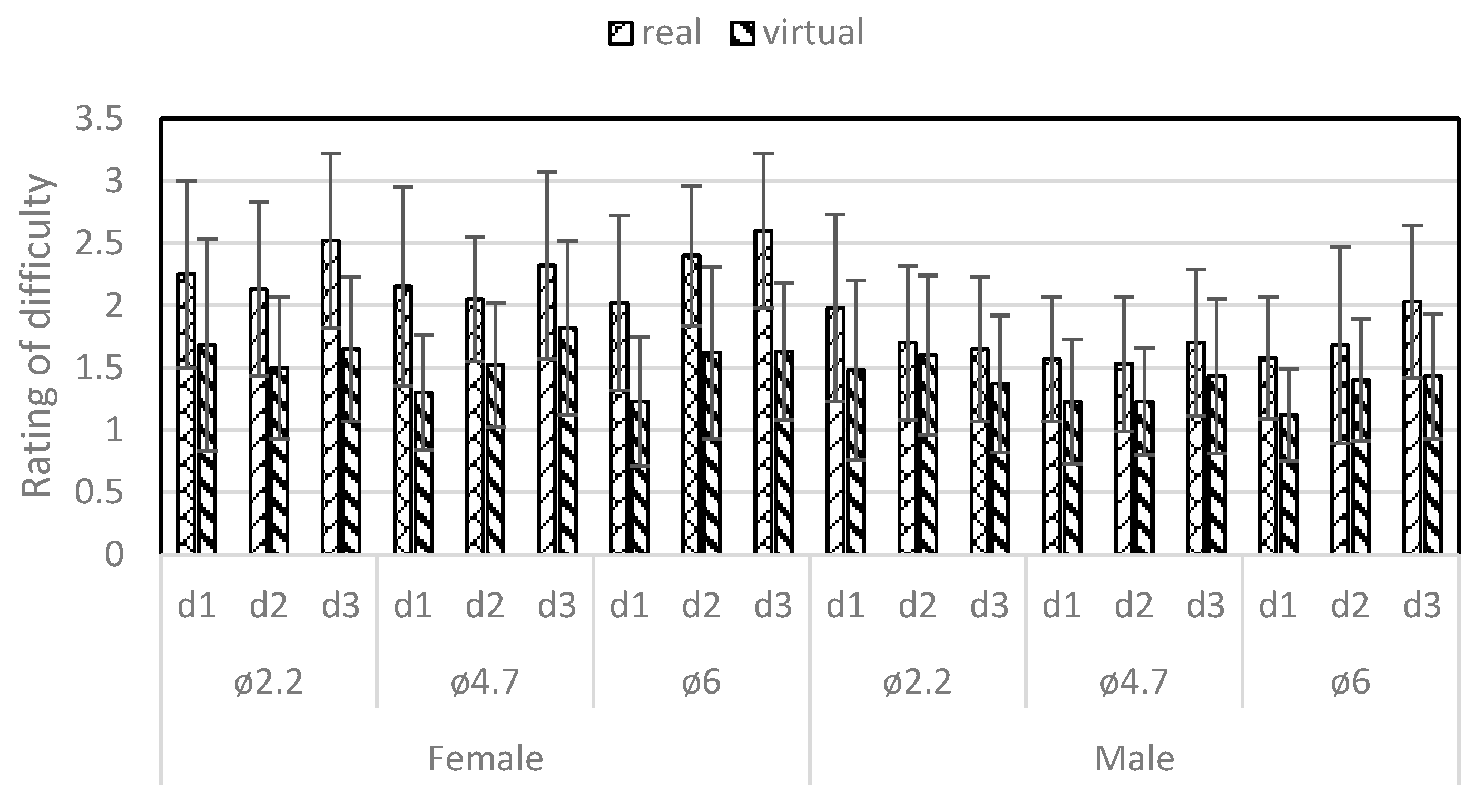
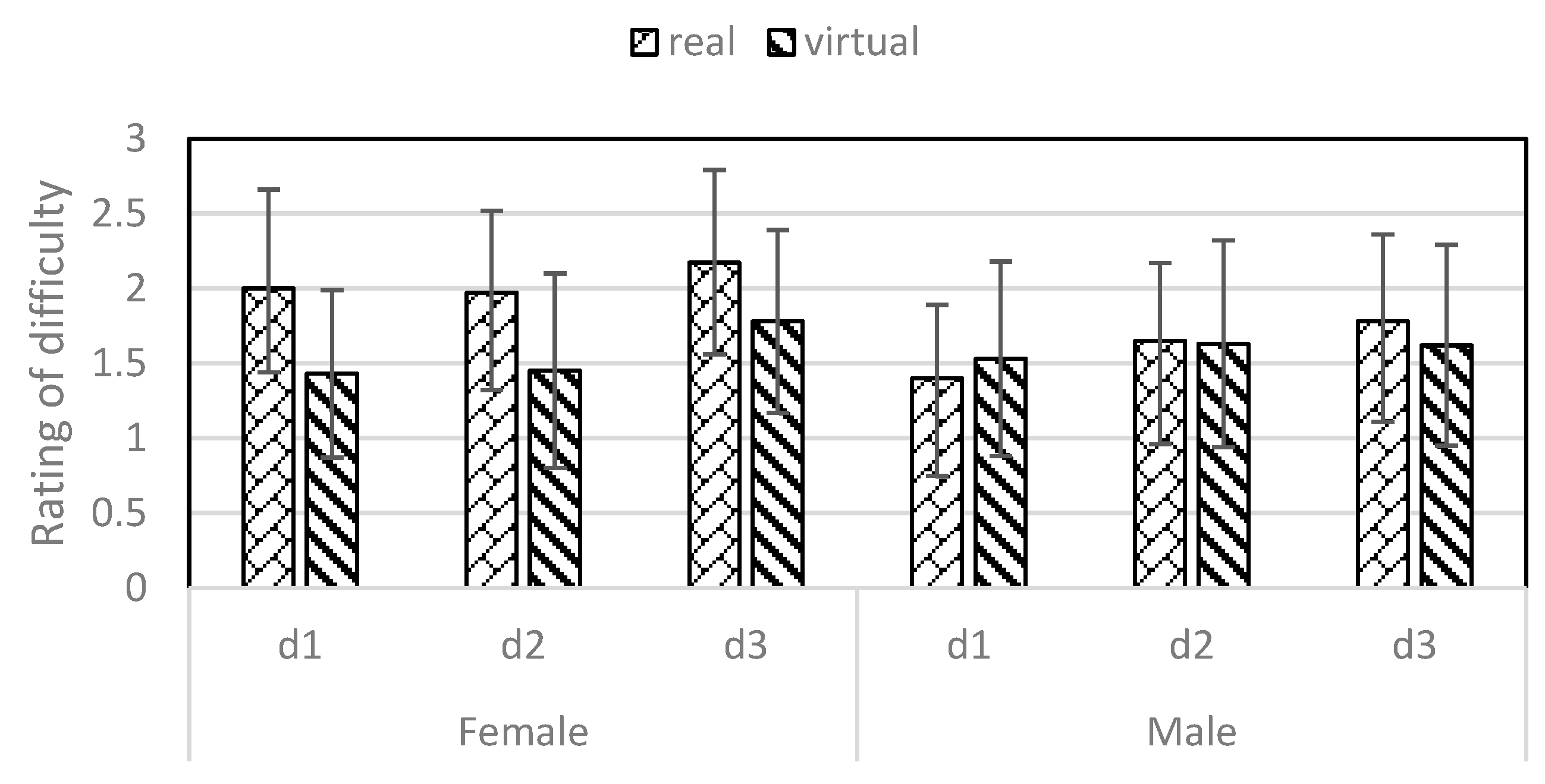
| Diameter (W) | d1 | ID1 | d2 | ID2 | d3 | ID3 |
|---|---|---|---|---|---|---|
| 2.2 | 12.5 | 3.51 | 25.0 | 4.51 | 37.5 | 5.1 |
| 4.7 | 23.5 | 3.32 | 47.0 | 4.32 | 70.5 | 4.9 |
| 6.0 | 32.0 | 3.42 | 64.0 | 4.42 | 96.0 | 5.0 |
| Transfer Direction | Pipe | Diameter | β1 | β2 | β3 | 1/β3 | Radj2 |
|---|---|---|---|---|---|---|---|
| Lateral | Real | 2.2 | −314.6 | 131.5 † | 465.5 | 2.1 | 0.91 |
| 4.7 | −204.2 | 190.1 †† | 506.6 | 2.0 | 0.91 | ||
| 6.0 | −316.2 | - * | 580.3 | 1.7 | 0.92 | ||
| Virtual | 2.2 | - * | - * | 291.2 | 3.4 | 0.93 | |
| 4.7 | −84.7 †† | - * | 317.7 | 3.1 | 0.95 | ||
| 6.0 | −66.5 † | - * | 306.5 | 3.3 | 0.96 | ||
| Anterior-posterior | Real | 2.2 | −196.5 †† | 235.9 | 426.2 | 2.3 | 0.91 |
| Virtual | 2.2 | −149.6 †† | - * | 319.7 | 3.1 | 0.88 |
Disclaimer/Publisher’s Note: The statements, opinions and data contained in all publications are solely those of the individual author(s) and contributor(s) and not of MDPI and/or the editor(s). MDPI and/or the editor(s) disclaim responsibility for any injury to people or property resulting from any ideas, methods, instructions or products referred to in the content. |
© 2023 by the authors. Licensee MDPI, Basel, Switzerland. This article is an open access article distributed under the terms and conditions of the Creative Commons Attribution (CC BY) license (https://creativecommons.org/licenses/by/4.0/).
Share and Cite
Li, K.W.; Nguyen, T.L.A. Movement Time and Subjective Rating of Difficulty in Real and Virtual Pipe Transferring Tasks. Appl. Sci. 2023, 13, 10043. https://doi.org/10.3390/app131810043
Li KW, Nguyen TLA. Movement Time and Subjective Rating of Difficulty in Real and Virtual Pipe Transferring Tasks. Applied Sciences. 2023; 13(18):10043. https://doi.org/10.3390/app131810043
Chicago/Turabian StyleLi, Kai Way, and Thi Lan Anh Nguyen. 2023. "Movement Time and Subjective Rating of Difficulty in Real and Virtual Pipe Transferring Tasks" Applied Sciences 13, no. 18: 10043. https://doi.org/10.3390/app131810043
APA StyleLi, K. W., & Nguyen, T. L. A. (2023). Movement Time and Subjective Rating of Difficulty in Real and Virtual Pipe Transferring Tasks. Applied Sciences, 13(18), 10043. https://doi.org/10.3390/app131810043







